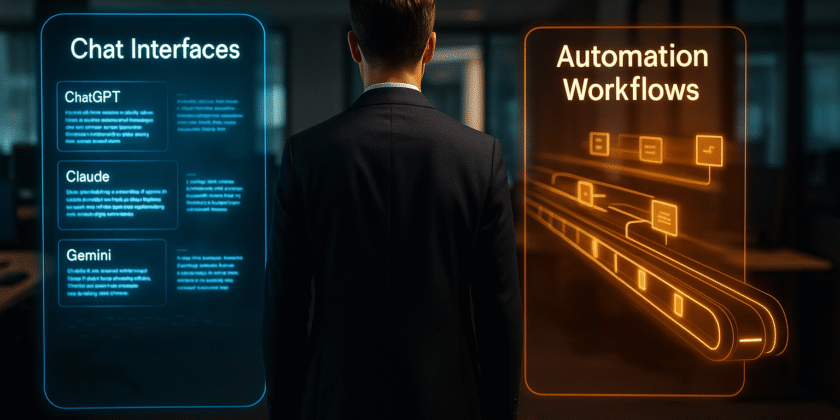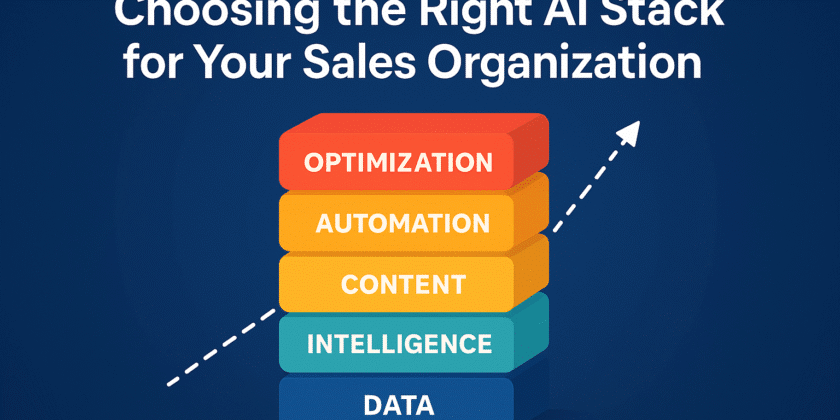A VP of Sales recently confided in me: “We have six different AI tools, but our reps are still doing manual work. What went wrong?”
This is the AI tool proliferation problem. Sales leaders often collect tools without a strategy, mistaking a pile of features for a cohesive system. It’s like buying a hammer, screwdriver, saw, and drill without realizing you’re actually trying to build a house. An effective AI stack means integration. When tools work together, they amplify each other’s value. When they don’t, they add complexity, confusion, and wasted money.
Why Strategy Beats Random Adoption
Random tool adoption is rampant across sales organizations. Teams chase shiny new software, often ending up with overlapping features, siloed data, and productivity lost to tool-switching. Instead of solving problems, the stack itself becomes the problem.
But when built strategically, the benefits are profound. Integrated systems reduce manual data entry, accelerate response times, and deliver actionable insights for reps. Three well-chosen, well-connected tools can outperform six isolated ones. Integrated stacks also improve adoption rates by providing consistent interfaces and reducing training overhead.
The Five-Layer AI Stack Framework
To avoid the chaos of random adoption, I use a five-layer framework for structuring sales AI tools:
- Data Foundation – Your CRM and data management system, enriched and maintained for accuracy.
- Intelligence & Analytics – AI-driven insights, lead scoring, forecasting, and market intelligence.
- Automation & Workflow – Sequences, task automation, and cross-platform orchestration.
- Content & Communication – AI writing, proposal generation, and customer-facing tools.
- Optimization & Learning – Conversation analysis, performance tracking, and continuous improvement.
These layers aren’t just categories; they’re connected through data flows and integration principles. Each layer enhances the next, creating a system that scales intelligently with your team.
Your foundation layer usually consumes about half of your AI stack budget, but it’s worth it. Clean, structured data is the lifeblood of every other tool. From there, intelligence and automation layers drive the bulk of ROI by improving deal velocity, conversion rates, and rep efficiency.
Content tools and optimization layers build on that foundation, ensuring customer-facing communication remains sharp while performance is continually refined. When done right, this phased approach allows organizations to see value in months, not years.
Too many organizations make predictable mistakes: choosing tools for features rather than integration, underestimating training and adoption costs, or layering new tools on top of dirty data. Others rush implementation without testing, or ignore governance and compliance until it’s too late. The result? Expensive tools with low adoption and little measurable impact.
The lesson is simple: treat your AI stack like architecture. Every decision influences the system’s stability and scalability for years to come.
Real-World Configurations
- Small teams may thrive with Pipedrive, Make.com, and ChatGPT handling CRM, workflows, and content.
- Mid-market firms often layer Salesforce, Gong, Outreach, and PandaDoc for stronger intelligence and automation.
- Enterprises combine Salesforce, advanced data platforms, SalesLoft, Gong, and dedicated optimization teams for scale.
These examples prove the point: success isn’t about tool count, it’s about fit, flow, and integration.
The Competitive Advantage of Integration
Companies with strategic AI stacks create barriers that their competitors can’t easily replicate. Data integration, consistent workflows, and continuous optimization compound value over time. The earlier you get your architecture right, the stronger your long-term advantage becomes.
And remember: the future of sales isn’t about humans versus AI. It’s about humans amplified by AI.
Immediate Action Items
- Inventory your current AI tools and map them to the five-layer framework.
- Identify missing layers and integration opportunities.
- Calculate the ROI of your current stack by measuring time saved, deals accelerated, and revenue uplift.
- Create a phased implementation plan using a 12-month roadmap.
- Establish data governance processes to protect the foundation of your stack.
- Pilot integrations before rolling them out team-wide.
If you want to go deeper into this topic, listen to Episode 7 of AI Tools for Sales Pros: Choosing the Right AI Stack for Your Sales Organization. You’ll find it on your favorite podcast player. Be sure to subscribe so you don’t miss the next episode: The AI Sales Process Map.











